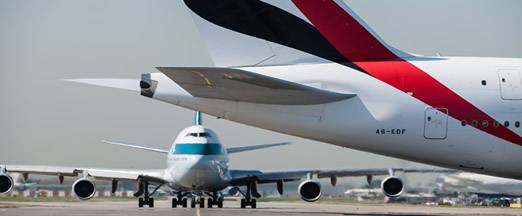Five ways to improve airport capacity without extra runways
25 November 2013Back in August I wrote about why measuring airport capacity means more than just tarmac and terminals. The same is equally true when it comes to increasing capacity.
But, before you can improve anything you need to understand its current level of performance and where improvements might be possible. At NATS we’ve developed tools and analysis methods that allow us to assess the key performance metrics of the air traffic management (ATM) operation both in the air and on the ground.
We use those tools to analyse things like airborne and ground based radar data, airport operational database logs, airline schedules and numerous other sources of information in order to build up a comprehensive understanding of the operation.
From this rich dataset we can then look at overall performance, benchmark it and then identify which elements are the most constraining.
1. Sharing information across the airport
An airport works much like a relay race where the team performance is dependent upon each individual runner. For an airport to operate efficiently – each part of the team – from the check-in and baggage handling through to air traffic control – has to be of an equally high standard.
Through years of support to the seasonal capacity declarations for some of the world’s busiest airports, NATS has a pretty unique understanding of just how important each component of an airport operation is. We use huge amounts of operational performance data to inform discussions with the rest of the airport community about how their individual contributions affect overall performance.
It sounds simple, but often when we do similar assessments overseas we find that the availability and sharing of this sort of information isn’t commonplace. And experience has shown that as soon as the right people are engaged and the right information is available to them, improving operational performance becomes part of the working culture.
2. Better use of what you have
Having two is not always better than one. We recently completed a capacity enhancement project for a busy international airport in the Sub-Continent where the two runways cross each other and therefore require aircraft movements to be carefully coordinated.
Through a detailed capacity review and benchmarking exercise, we were able to recommend that the airport should focus its efforts on using just one runway to provide what’s called HIRO – High Intensity Runway Operations.
We used state-of-the-art fast-time simulation tools to evaluate the potential gains and as a result, the consistency and performance of the airfield has been boosted together with an increase in the declared capacity. The second runway is still available if needed, but is now only used tactically or as a contingency.
3. Balancing demand
If two or more runways are available and can be used independently of each other, then the key to maximise capacity is to ensure each can be fully utilised at all times.
This can be achieved by flexing the mode of operations and allowing take off and landings from each runway. This can then provide short term relief for arrival or departure peaks and will also ensure individual runway demand is as balanced as it can be.
By looking at the airport operations against the challenges posed by airline schedules, it is then possible to find ways to enhance performance. As part of a typical assessment we would normally use simulation and other tools in order to understand the operational impacts.
A good example from a recent study is where we were able to demonstrate capacity benefits by revealing the trade-offs of additional taxi time and fuel burn for using a non-preferred runway, compared to a short taxi time but a longer wait when operating off a closer runway.
4. Getting your sequence right
Arrival Manager – or AMAN – is an advanced controller support tool that provides real-time information on the optimum landing sequence for aircraft arriving at busy capacity constrained airports. Because different sizes of aircraft need to be separated to varying distances, getting that optimum order right is absolutely fundamental to maintaining capacity and throughput.
Similarly, tools such as the TSAT (Target Start-up Approval Time, which gives individual aircraft an optimal time to start their engines prior to departure) can significantly improve the departure start-up order and sequence, thereby reducing delay and enhancing capacity.
This is something that is a key focus for NATS within our own operations in the UK, but it’s also something that we are supporting other organisations with around the world.

Aircraft queuing at Changi Airport, Singapore. NATS has been working at the airport to help increase capacity. Image by Simon_sees vis Flickr
5. Being consistently consistent
Probably the most important factor for maximising airport capacity without building any new infrastructure is simply the ability to consistently deliver an efficient operation.
This sounds obvious, but when we do capacity enhancement projects around the world, this is typically the least understood area. We use our data capture and analysis tools to provide airport operators with the evidence which demonstrates where inefficiencies lie. Our air traffic experts are then able to interpret that information and through observing the live operation, are able to recommend changes to deliver a much more consistent service. Our simulation tools can then predict what the capacity gains would be.
Quite often these gains can be considerable. For example, a 10-25% potential capacity increase is not uncommon and in some cases it can be much more.
Comments
Please respect our commenting policy and guidelines when posting on this website.





26.11.2013
09:11
James Creegan- Rockshore
Very interesting article- I wonder how many of these benefits can be quantified?
Although many of the methods described above don’t require a large investment from the airport (certainly not comparable to increasing the infrastructure) the question I’m asked most often in my role is how much of an improvement will certain changes make. It’s not always an easy question to answer!
26.11.2013
11:00
Nick Stevens
Principal ConsultantHi James, it is a good question and one that our customers are very keen to understand. Our assessments are often used to develop business cases for change, so being able to accurately quantify the benefits is a key requirement and one that is central to any project we undertake.
NATS utilises the full range of business areas we have available including operational analysis, simulations, air traffic control, human factors, safety and engineering in order to accurately predict what the future operation will look like and therefore what the impact of the change is likely to be, and what business benefits it will deliver.
11:00
Nick Stevens
Principal Consultant06.11.2014
12:02
Ahmed F El-Sayed
I’m impressed by the article. Being coordinator,I invite you to participate in the first aviation engineering innovations conference
http://aeic.iaet-eg.org
Luxor, Egypt, 21-22 March, 2015
30.11.2014
16:13
Rodolfo
One of the restrictions in airport capacity expansion is the separation needed between landing aircraft, so they won’t penetrate the preceding one’s wake. To decrease horizontal separation, while maintaining safety, is having subsequent aircraft pair in two different levels.
With two ILS beams with different slopes, one aircraft would use the steeper glide slope, while the next one the shallower. A concern is that both vectors intersect at the beginning of the runway but the ground attenuates the wake faster than on clear air before the next aircraft lands. Heavier aircraft would be assigned to the shallower glide slope due to its stronger and descending wake.
From a financial point of view, the flight director of aircraft would not have to be modified since ATC would assign the ILS frequencies alternatively.
25.07.2016
02:04
Kundan Srivastav
Is Mumbai airport the one you are talking about, with respect to criss-cross runways?
22.04.2018
11:07
Naoaki "Nick" Eguchi
Hi Nick,
It was a very interesting article. I know that Dublin airport use HIRO. Can you tell me which other airports use HIRO. Will this be ICAO standard?
Best regards,
Nick
30.01.2020
14:38
TG Vijayaraj
Very impressive article on capacity enhancement.